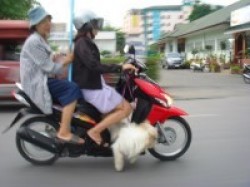ATTRACTIONS TO VISIT
Chiang Mai weather has minimal impact on when you should visit.
To help you decide when to come, we give you the following basic weather information.
Meteorologically speaking, it is always summer here.
This summer is divided into three seasons: cool/dry, hot/dry, and warm/rainy.
Like museums, restaurants, craft and temples, most vegetables and trees here can be admired all year round.
The Cool Season, from November to February
This is the most popular tourist season,
since it is the coldest time of the year in northern Eurasia and North America.
However, hotel prices are top high and you may find some popular restaurants and attractions overcrowded.
The Chiangmai climate is rather pleasant this time of the year; the risk of rain is very low
and some species are in beautiful blossom, such as Congea and Cochlospermum (January),
Rhododendron and Cassia bakeriana at Doi Inthanon (mid February).
The Flowering Season lasts from March to May.
In April, you may see the exquisite Thai national tree, Cassia fistula, in majestic, golden blossom,
and pick fruits of Strychnos nux-vomica.
In April, we celebrate Songkran for several days, i.e. splashing water on everything that moves,
very funny and coooooling!
This is also the time of the mouthwatering mango season and you can admire
local flowers like Afzelia xylocarpa and Crateva adansonii.
In May you can experience the fantastic Siamese tulips, the Curcumas, in blossom
as well as other gingers and orchids.
The Green Season lasts from June to October.
In the late hot season and early rainy season, butterflies reach their peak in numbers.
The Golden Birdwing butterfly is aorund from late May until early September.
During the rainy season, the country is covered in various shades of emerald green,
and western expatriates here believe this is the prettiest time of the year.
This is, of course, the season of wild mushrooms, colourful and strange in shape,
which are picked, cooked and enjoyed by locals.
You may see Mussaenda kerrii in blossom and lovely green rice fields.
Hotel prices are lower due to low tourist season.
As for rain, our experience is that the rains come in the late afternoon/evening.
In any case, tropical rains are heavy, short and not cold.
In October the rains are less frequent, but occasional storms may occur.
Gratefully extracted from Dokmai Garden’s website:
http://www.dokmaigarden.co.th/weather.php
Attractions in Chiang Mai
At times, it is hard for a short-time visitor to find local attractions that coincide with their interests.
If you like nature, gardening, food, history, handicrafts, and local traditions, we can help you establish contacts on a personal level once we meet at Dokmai Garden.
Our network of friends in villages, temples, universities, and national parks will be most useful.
Dokmai Garden is situated at the border of Obkhan National Park,
which borders two other national parks (see below).
Below, we list a few of the nearby destinations, but there are many more places of interest,
further north, east and west.
The distance in km refers to the driving distance from the Asian Healing Arts Center.
The Grand Canyon of Nampreh - 3 km
When the Canal road (a.k.a. Klong Cholprattan) was being constructed,
it was raised by 2 meters and the soil came from an area which is now called the Grand Canyon of Nampreh as it has deep craters of red soil with plenty of small lakes where you can go fishing.
Hang Dong food market - 4 km
Here you can apply what you learnt at Dokmai Garden -
by trying to identify fruits and vegetables for sale by local farmers to local villagers.
Very few speak English.
Hang Dong Ban Tawai - 4 km
This is Thailand's most famous street for woodworking items, antique and furniture sales.
Obkhan National Park - 6 km
Here you can see trees and animals in their natural habitat, and,
with the introduction we gave you at Dokmai Garden,
you may even recognise individual species - while at the same time enjoy the jungle.
We collaborate closely with villagers and rangers, and, again, very few speak English.
Sanpatong Saturday market - 7 km
Unlike the night bazaar, which is aimed at tourists, this market caters to Thai farmers.
You can buy water buffaloes, cows, fruits, vegetables, seedlings, roosters, living beetles,
deliciously deepfried bananas, clothes, tools, etc.
Make sure to be there around 08:00 in the morning, since everything ends at 11:00 a.m.
The Night Safari - 12 km (close to the Royal Flora SHow)
We believe this is a good place to see native Thai mammals.
Although civets, gibbons and leopard cats are present in the national parks,
they are very hard to spot. Here, you can conveniently study them.
The Royal Flora Show - 13 km (close to the Night Safari)
This is a large botanical garden, suitable for picnics and studies of e.g. bonsais.
Doi Suthep National Park, the Zoo and the Arboretum - 17 km
There are many highlights on the route to the crest of this mountain,
which hovers above Chiangmai.
At the base, you will find the arboretum and the zoo.
The zoo contains interesting species from all over the world,
but be prepared for an exhausting walk up-hill and crowds of people,
especially so on the weekends.
The Doi Suthep temple is Chiangmai's biggest tourist attraction.
Higher up on the mountain is the beautiful Royal Puping Palace.
This palace hosts some high-elevation tree species and interesting architecture.
If you keep driving till the end of the road, you will find a nice camping ground.
No need to bring anything; everything can be rented.
Baan Phorliangmeun's Terracotta Arts in Lamphun, 20 km
This private garden is an outdoor showroom for terracotta art, inspired by Khmer design.
The clay excavation has resulted in an interesting landscape with ponds, bridges
and shade trees of many species.
The owner has a large collection of bonsais.
Tweechol Botanical Garden in Doi Saket - 42 km
This large recreational park, complete with hotel, playgrounds, a zoo and paddleboats,
is a nice family destination.
The garden design is aimed at modern Thai taste, i.e., formal, with cut hedges and perfect lawns.
The topiaries are of highest quality and appreciated by all ages.
The Queen Sirikit Botanic Garden in Mae Rim - 46 km
This national garden has a vast collection of native orchids
and splendid greenhouses in the midst of native forests.
A very scenic area!
Wat Phrayun in Lamphun - 46 km
This ancient and quiet temple is the home of gigantic Corypha umbraculifera palm trees.
The head monk is interested in botany and has provided us with seedlings.
Lamphun is an ancient city with ruins from the time before the arrival of the Thais.
Doi Inthanon National Park - 50 km
This is Thailand's highest mountain, with pine forests and native Rhododendrons
crowded with orchids and other epiphytes.
This is a wonderful national park that would take more than a life time to fully explore.
Doi Chompo Po Ka National park - 400 km
In this remote national park in the Nan province,
you may find species endemic to this mountain,
but also tigers, leeches and other exciting beings.
The Bretschneidera, a lovely tree with only ten specimens left in the wild,
is in blossom in February.
Courtesy of Dokmai Botanical Gardens.
www.visit-chiang-mai-online.com/dokmai-garden.html
To contact us, click here !



